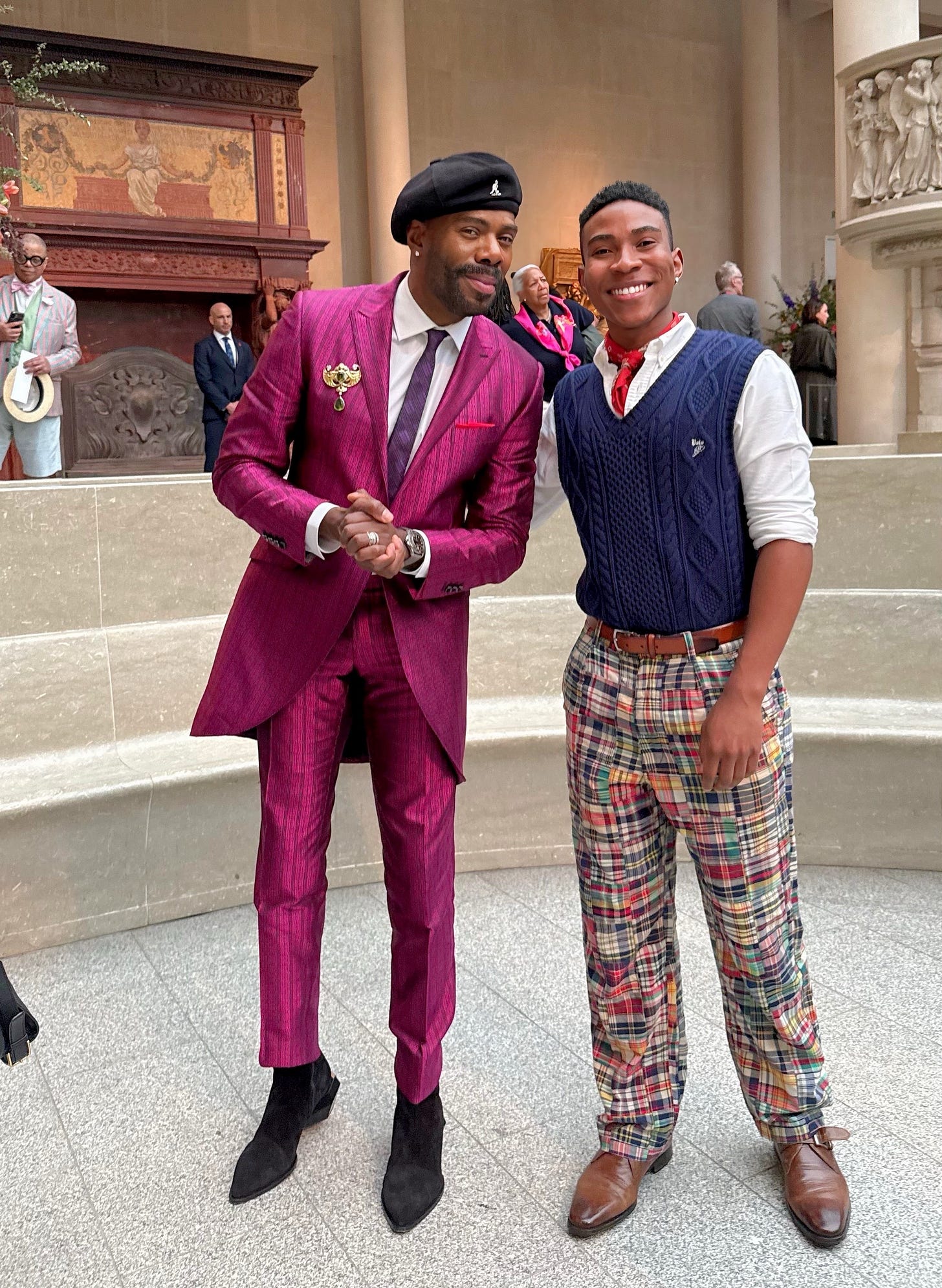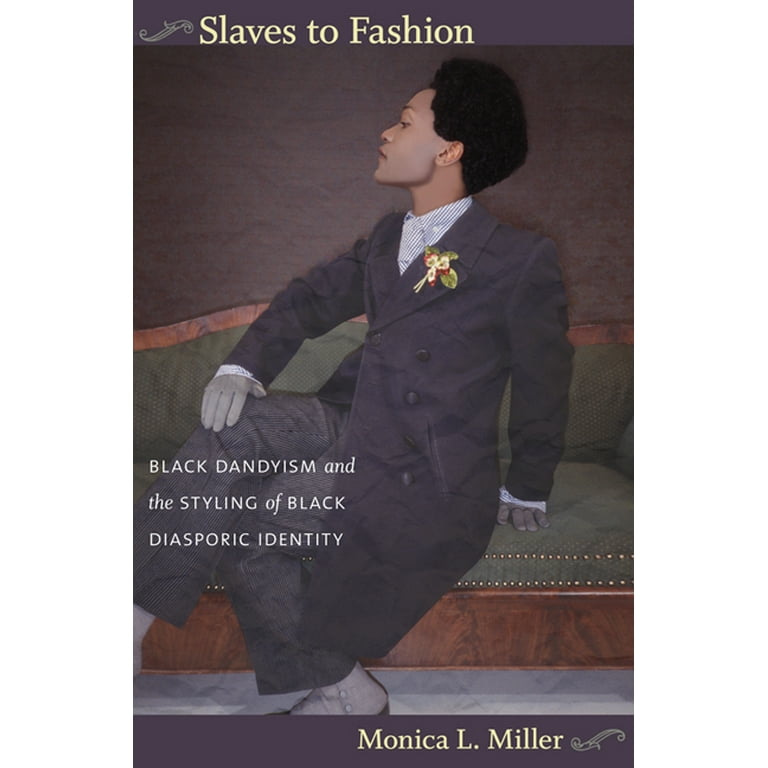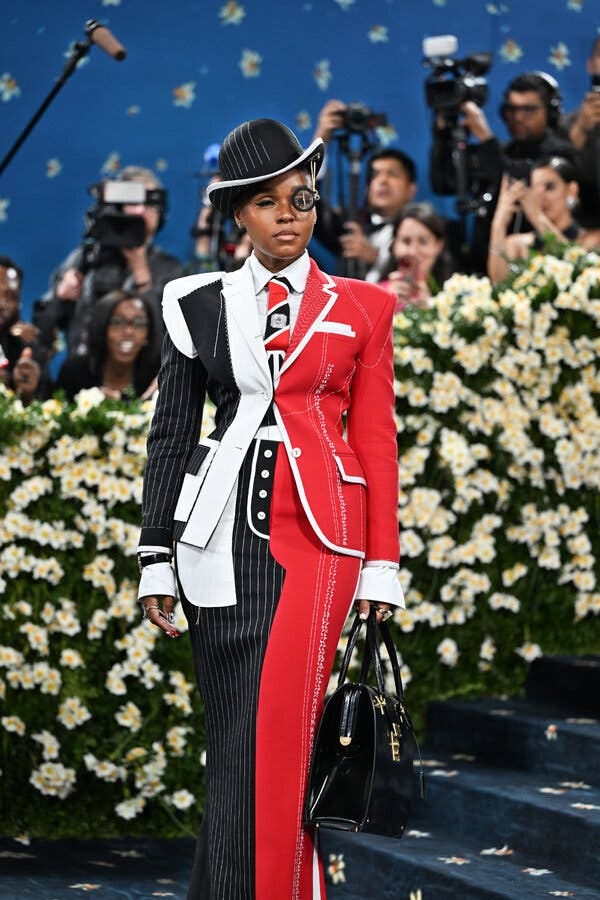[Exclusive] I Got a Behind-the-Scenes look into the Met Gala and Learned the History of the Black Dandy
At a sneak preview of the Costume Exhibition hours before the Gala, The Met Showed Us the Story of the Black Dandy: from Frederick Douglass to Andre 3000
The Met Gala lit up Manhattan last night (and will take over our social media feeds today) with celebrities draped in the finest fashions, celebrating the theme: "Superfine: Tailoring Black Style." This is the first exhibition in the museum's history focused entirely on Black men's fashion contributions.
I wrote this fresh from an exclusive preview of the Costume Institute's exhibition hours before the gala began, a rare invitation extended because of my work documenting historical erasure (and because readers like you have helped this newsletter reach new heights). In attending, I learned that beneath the glamour lies a revolutionary story of resistance dating back centuries, one that challenges the current administration's alarming campaign to erase Black history from our national narrative.
I'm fighting to document cultural resistance stories like Black dandyism before they're dismissed as "woke propaganda" or erased entirely—and I need your help!
With no corporate backing or wealthy sponsors, this work depends entirely on readers like you. If everyone reading this became a paid subscriber, I could investigate these historical connections full-time, but right now less than 3% of my followers are paid subscribers.
If you believe in journalism that preserves what others would erase, please consider a paid subscription today!
History Can't Hide from Kahlil Greene is a reader-supported publication. To receive new posts and support my work, consider becoming a free or paid subscriber.
When Fashion Becomes Revolution
"God created Black people and Black people created style."
These words from playwright George C. Wolfe, quoted by Oscar-nominated actor Colman Domingo during the exhibition's press conference, perfectly capture the exhibition's spirit. Standing in a brightly lit museum room in front of big names like Anna Wintour and Ozwald Boateng, Domingo shared deeply personal reflections about how his father, brother, and stepfather shaped his understanding of dandyism. From his father's tight Italian flared trousers to the "preacher robes" he wore when "representing the Lord," (which Domingo wryly noted came from "one of the biggest womanizers that this planet has ever seen.")
The history presented by Hughes and showcased in the exhibit tells a profound story. In 18th-century Britain, the term "dandy" described men obsessed with refined appearance. Black dandyism evolved into something far more significant during the Harlem Renaissance, when figures like Langston Hughes transformed European fashion traditions into statements of dignity and resistance against racial oppression.
As Monica L. Miller, guest curator and author of "Slaves to Fashion: Black Dandyism and the Styling of Black Diasporic Identity," explains through the exhibition, dandyism became a way to "defy the rigid categories of race and class" in a society determined to confine Black expression. The sharp suit, polished shoes, and precise accessories weren't just fashion choices. They were declarations of humanity in a world that denied it.
The Art of Resistance
I was struck by how Black dandyism represents the perfect counter-strategy. When direct resistance was impossible, fashion became a subversive language. The exhibit showcases how dandyism evolved from the post-Emancipation period through the Harlem Renaissance when Harlem became the epicenter of Black intellectual thought.
The legacy continues today through designers like Bianca Saunders, who has three pieces displayed. Standing before her white cotton shirt and black twill pants, Saunders explained that she always viewed dandyism through her friends and "how they can present themselves." For her, the exhibit "reminds me of all the things that I've worked so hard to be a part of."
The modern Black dandy embraces bespoke tailoring, extravagant accessories, and bold colors, but the significance remains potent. Each outfit represents what the exhibit calls "an assertion of autonomy, beauty, and power in the face of a world that continues to attempt to restrict Black expression."
The Exhibits They Don't Want You To See
The timing couldn't be more pointed, and Hughes and the other curators who spoke at the event alluded to this many times. Not too long ago, President Trump's executive order targeted the National Museum of African American History and Culture for being "divisive.” At around that time, museum director Kevin Young submitted his resignation, prompting speculation that the two events were connected.
This continues the pattern from Trump's first term, when he banned "divisive concepts" in federal training, targeting initiatives like the 1619 Project while creating the 1776 Commission to produce "patriotic education" that minimized slavery's impact on American institutions. The parallels to Florida Governor Ron DeSantis's 2023 rejection of the AP African American Studies course are also impossible to ignore. DeSantis claimed the course was "trying to use Black history to shoehorn in queer theory" and was imposing "a political agenda" on students.

Walking through this exhibition, I was struck by how spectacularly that argument misses the mark. The very dandyism celebrated here inherently challenges rigid gender norms and demonstrates why queer history is inseparable from Black cultural expression and resistance. What white Republican leaders dismissed as inappropriate "agenda" is revealed here as vital cultural context that white politicians simply couldn't—or wouldn't—understand.
The assault on Black history has a clear purpose: to prevent Americans from understanding that racism isn't just about individual prejudice but a system built and maintained through centuries of law, policy, and violence. By controlling the narrative, they attempt to erase not just history but models of resistance—like dandyism—that might inspire future generations.
When Museums Become Memory Keepers
If government institutions can be forced to erase historical truths, cultural spaces like museums become vital guardians of memory. The Met Gala's celebration of Black dandyism isn't just a fashion statement but a defiant preservation of history the administration would rather you forget.
From hand-stitched suits to perfectly cut trousers, from the bold patterns that rejected somber European traditions to accessories chosen with deliberate purpose, Black dandies created what the exhibition calls "an elegant middle finger to a society that sought to define them by race, not character."
Last night, as celebrities climbed the famous Met steps, they were participating in more than fashion's biggest night. They continue a centuries-old tradition of using style as resistance, preserving history through every stitch, color, and silhouette when government institutions fail us.
Maybe that's why the administration tries so hard to control cultural spaces. They understand what dandies have always known: sometimes the most powerful resistance isn't shouted in the streets but worn proudly on your back.
But here's the grim reality: as Black stylistic rebellion enters the Met, support for documenting these cultural resistances vanishes.
Remember all those corporate diversity commitments from 2020? The fashion brands that suddenly discovered Black designers? The museums promising inclusive programming? They've largely disappeared. Major companies that once proudly proclaimed "Black Lives Matter" are now quietly pulling sponsorships from Black history initiatives, treating racial justice like last season's trend.
Cultural institutions that should safeguard this history, including museums nationwide, are proving they can't withstand political pressure. When the National Park Service begins removing Harriet Tubman information and the National Museum of African American History faces executive orders calling it "divisive," we see how easily institutional memory can be erased.
The reality is stark: we need Black-owned resources documenting our historical resistance, platforms we control that can't be dismantled when political winds shift, just as Black dandies controlled their self-presentation when other forms of autonomy were denied.
Right now, less than 4% of my followers are paid subscribers. What could we accomplish with more support?
🖋️ At 5% paid subscribers: I could interview Black designers, stylists, and fashion archivists preserving the history of Black dandyism before their knowledge is lost.
📷 At 10% paid subscribers: I could create detailed documentation of Black style as resistance across America, building a digital archive beyond what institutions like the Met can showcase.
🧵 At 20% paid subscribers: We could develop educational materials about Black fashion as political resistance for schools where this history is being erased or never taught.
I will be very upfront: You might think someone else will fund this work, but that's precisely what everyone else is thinking too. This only works if we contribute what we can—just the cost of a coffee each month.
This isn't just about keeping a newsletter alive. It's about fighting back against a wave of revisionism that would strip Black creativity of its revolutionary context and reduce it to mere aesthetics.
If you are having trouble upgrading your subscription with the above link, visit historycanthide.substack.com/subscribe
Addition: Some of you preferred a one-time donation over a full subscription. To do that you can “Tip” me on Venmo (TheGenZHistorian) or Cashapp ($kahlilgreene00).
References:
Gaskins, Ty. "Black Dandyism Explained—From Its 18th-Century Roots to Modern-Day Expressions." Vogue, April 29, 2025.
Walk, Trey. "The Trump Administration's Assaults on Black History." Human Rights Watch, April 10, 2025.
Aversa, Ralphie. "Colman Domingo reveals his top fashion inspiration at Met Gala preview." USA TODAY, May 5, 2025.
Gibson, Kelsie. "Met Gala 2025: A Full Red Carpet Recap from Fashion's Biggest Night." PEOPLE, May 5, 2025.
Miller, Monica L. "Slaves to Fashion: Black Dandyism and the Styling of Black Diasporic Identity." 2009.
Contorno, Steve and Kit Maher. "DeSantis says Florida rejected new AP course on African American Studies for imposing 'political agenda'." CNN, January 23, 2023.












I am a fiber artist and I so envy your getting to go to this. Black fashion and style have always been a thing of beauty for me (I see humans as works of art). The bold colors and patterns, and the crisp tailoring scream "I am my own person." When worn, the way the wearer moves or stands showcases the clothing, but also sends messages of confidence, pride, and joy. There is no blending in. The person exudes a certain amount of fearlessness in their right to take up space. It is said that clothes make the man.
Thank you so much for sharing this. You have made my artists heart sing this morning and yearn to get back to my own machine to create.
So glad The Met has this exhibition and appreciate you being there to bring it to us. Thanks Kahlil!